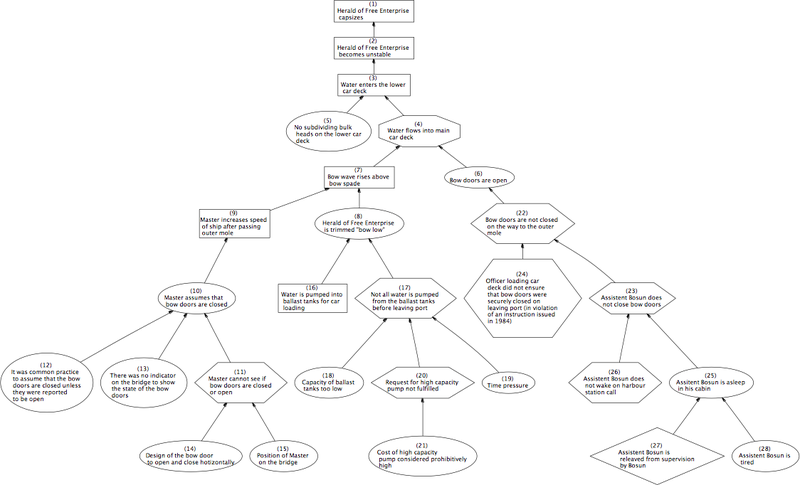36:
193:
WBA starts with the question "What is the accident or accidents in question?". In most cases this is easy to define. Next comes an iterative process to determine causes. When causes for the accident have been identified, formal tests are applied to all potential cause-effect relations. This process
235:
Only if for all causal relations the CT is positive and for all sets of causes to their effects the CST is positive the WBG is correct: each cause must be necessary (CT), and the totality of causes must be sufficient (CST): nothing is omitted (CST: the listed causes are sufficient), and nothing is
245:
225:. The CT asks the following question: "If the cause had not been, could the effect have happened?". The CT proves or disproves that a cause is a necessary causal factor for an effect. Only if it is necessary for the cause in question then it is clearly contributing to the effect.
232:– The CST asks the question: "Will an effect always happen if all attributed causes happen?". The CST aims at deciding whether a set of causes are sufficient for an effect to happen. The missing of causes can thus be identified.
147:. It is independent of application domain and has been used to analyse, among others, aviation-, railway-, marine-, and computer-related accidents and incidents. It is mainly used as an after-the-fact (or
326:
53:
317:
100:
72:
119:
79:
386:
86:
57:
68:
376:
222:
46:
249:
202:
198:
381:
366:
330:
266:
182:
175:
93:
296:
271:
218:
194:
can be iterated for the newfound causes, and so on, until a satisfactory result has been achieved.
371:
244:
140:
281:
171:
167:
319:
Analysing
Aviation Accidents Using WB-Analysis - an Application of Multimodal Reasoning
152:
360:
17:
148:
144:
350:
35:
197:
At each node (factor), each contributing cause (related factor) must have been
291:
286:
276:
179:
261:
170:
used to represent interdependencies within a system. The WBG depicts
243:
201:
to cause the accident, and the totality of causes must have been
178:
where the nodes of the graph are factors. Directed edges denote
29:
27:
Method for accident analysis to determine causal relationships
327:
Association for the
Advancement of Artificial Intelligence
151:) analysis method. WBA strives to ensure objectivity,
60:. Unsourced material may be challenged and removed.
248:Partial Why–because graph of the capsizing of the
8:
316:Ladkin, Peter; Loer, Karsten (April 1998).
236:superfluous (CT: each cause is necessary).
120:Learn how and when to remove this message
174:between factors of an accident. It is a
308:
7:
58:adding citations to reliable sources
25:
221:' formal notion of causality and
155:and reproducibility of results.
34:
45:needs additional citations for
1:
217:(CT) – The CT leads back to
403:
250:Herald of Free Enterprise
158:The result of a WBA is a
387:Problem solving methods
230:causal sufficiency test
252:
176:directed acyclic graph
69:"Why–because analysis"
247:
185:between the factors.
351:Why-Because Analysis
325:. Spring Symposion.
133:Why–because analysis
54:improve this article
18:Why-Because analysis
297:Root cause analysis
272:Fault tree analysis
215:counterfactual test
267:Cause–effect graph
253:
139:) is a method for
377:Accident analysis
160:why–because graph
141:accident analysis
130:
129:
122:
104:
16:(Redirected from
394:
338:
337:
335:
329:. Archived from
324:
313:
282:Ishikawa diagram
209:The formal tests
172:causal relations
125:
118:
114:
111:
105:
103:
62:
38:
30:
21:
402:
401:
397:
396:
395:
393:
392:
391:
382:Directed graphs
367:Causal diagrams
357:
356:
347:
342:
341:
333:
322:
315:
314:
310:
305:
258:
242:
223:counterfactuals
211:
191:
168:causal notation
126:
115:
109:
106:
63:
61:
51:
39:
28:
23:
22:
15:
12:
11:
5:
400:
398:
390:
389:
384:
379:
374:
369:
359:
358:
355:
354:
346:
345:External links
343:
340:
339:
336:on 2022-12-21.
307:
306:
304:
301:
300:
299:
294:
289:
284:
279:
274:
269:
264:
257:
254:
241:
238:
210:
207:
190:
187:
153:falsifiability
128:
127:
42:
40:
33:
26:
24:
14:
13:
10:
9:
6:
4:
3:
2:
399:
388:
385:
383:
380:
378:
375:
373:
370:
368:
365:
364:
362:
352:
349:
348:
344:
332:
328:
321:
320:
312:
309:
302:
298:
295:
293:
290:
288:
285:
283:
280:
278:
275:
273:
270:
268:
265:
263:
260:
259:
255:
251:
246:
239:
237:
233:
231:
226:
224:
220:
216:
208:
206:
204:
200:
195:
189:WBA in detail
188:
186:
184:
181:
177:
173:
169:
166:), a type of
165:
161:
156:
154:
150:
146:
142:
138:
134:
124:
121:
113:
110:February 2018
102:
99:
95:
92:
88:
85:
81:
78:
74:
71: –
70:
66:
65:Find sources:
59:
55:
49:
48:
43:This article
41:
37:
32:
31:
19:
331:the original
318:
311:
234:
229:
227:
214:
212:
196:
192:
180:cause–effect
163:
159:
157:
149:a posteriori
145:graph theory
136:
132:
131:
116:
107:
97:
90:
83:
76:
64:
52:Please help
47:verification
44:
219:David Lewis
361:Categories
303:References
292:Issue tree
205:to do so.
203:sufficient
80:newspapers
372:Debugging
287:Issue map
277:Five whys
199:necessary
183:relations
262:Accident
256:See also
240:Example
94:scholar
143:using
96:
89:
82:
75:
67:
353:(WBA)
334:(PDF)
323:(PDF)
101:JSTOR
87:books
228:The
213:The
73:news
164:WBG
137:WBA
56:by
363::
162:(
135:(
123:)
117:(
112:)
108:(
98:·
91:·
84:·
77:·
50:.
20:)
Text is available under the Creative Commons Attribution-ShareAlike License. Additional terms may apply.
